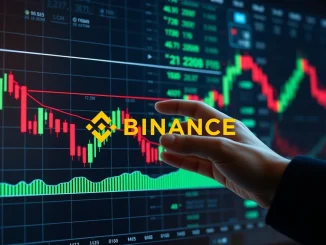
Heads up, crypto enthusiasts in Europe! If you’re trading stablecoin pairs on Binance within the European Economic Area (EEA), you need to pay close attention. A significant regulatory shift is underway, and it’s about to impact your trading strategy. Binance, a leading global cryptocurrency exchange, has just dropped a bombshell announcement regarding stablecoins and the EU’s groundbreaking Markets in Crypto-Assets (MiCA) regulations. Let’s dive into what this means for you and how to navigate these changes.
Why is Binance Delisting Stablecoin Pairs for EEA Users?
The core reason behind this delisting is the European Union’s MiCA regulations. These regulations are a comprehensive framework designed to bring clarity and structure to the crypto-asset market within the EU. MiCA aims to protect consumers and ensure market integrity, and a key part of this involves setting standards for stablecoins. Binance, as a responsible global exchange, is proactively adapting to these new rules. Specifically, certain stablecoins currently offered on the platform do not meet the MiCA regulations requirements for issuers operating within the EEA. To ensure compliance and maintain a regulated environment for its users, Binance is taking preemptive measures.
Which Stablecoins are Affected by the Binance Delisting?
The delisting isn’t a blanket ban on all stablecoins. It’s targeted at specific stablecoin pairs that involve assets deemed non-compliant with MiCA. Here’s a list of the stablecoins that will be affected for EEA users starting March 31st:
- USDT (Tether)
- FDUSD (First Digital USD)
- TUSD (TrueUSD)
- USDP (Pax Dollar)
- DAI (Dai)
- AEUR (AgEUR)
- UST (TerraUSD – Classic)
- USTC (TerraClassicUSD)
- PAXG (Pax Gold)
It’s important to note that this delisting applies to trading pairs involving these stablecoins, not necessarily the stablecoins themselves for all functionalities. Keep reading to understand what this means for your holdings.
What Does ‘Delisting Trading Pairs’ Actually Mean for EEA Binance Users?
Delisting trading pairs means that Binance will no longer offer trading markets where you can directly exchange the listed non-MiCA compliant stablecoins for other cryptocurrencies or fiat currencies within the EEA region. Think of it like this: if you wanted to trade USDT for Bitcoin (BTC/USDT pair) or USDT for Euro (EUR/USDT pair) on Binance within the EEA after March 31st, you won’t be able to do so directly. However, crucially, Binance has stated that:
- Withdrawals of Non-Compliant Stablecoins Remain Available: You can still withdraw these stablecoins from your Binance account.
- Deposits of Non-Compliant Stablecoins Remain Available: You can still deposit these stablecoins into your Binance account.
This is a significant distinction. Your funds are not locked, and you retain control over your assets. The change primarily impacts direct trading of these specific stablecoin pairs on Binance for EEA users.
What are MiCA Compliant Stablecoin Alternatives?
Binance isn’t leaving EEA users without options. They are encouraging users to transition to stablecoin compliance alternatives that are expected to align with MiCA regulations. The exchange specifically highlighted two such alternatives:
- USDC (USD Coin): A popular and widely accepted stablecoin known for its regulatory focus and transparency.
- EURI (EURC): A Euro-backed stablecoin, providing a direct link to the Euro currency within the crypto space.
These stablecoins are presented as viable alternatives for EEA users who wish to continue trading stablecoin pairs on Binance within a MiCA-compliant framework. Consider exploring these options if you frequently trade the delisted pairs.
Actionable Steps for Binance EEA Users: How to Prepare?
If you are an EEA user on Binance and hold any of the affected stablecoins or frequently trade the listed pairs, here’s what you should do:
- Review Your Holdings: Check your Binance wallet and identify if you hold any USDT, FDUSD, TUSD, USDP, DAI, AEUR, UST, USTC, or PAXG.
- Assess Your Trading Activity: Determine if you regularly trade pairs involving these stablecoins.
- Consider Conversion: If you actively trade these pairs, think about converting your holdings to MiCA-compliant alternatives like USDC or EURI. Binance encourages this conversion.
- Explore Alternative Trading Strategies: If you prefer to keep holding the non-compliant stablecoins, you can still withdraw them and potentially use them on other platforms or for other purposes outside of direct Binance trading pairs within the EEA.
- Stay Informed: Keep an eye on Binance’s official announcements and further updates regarding MiCA compliance and stablecoin offerings.
EEA Crypto Regulation: What’s the Bigger Picture?
Binance’s decision is a direct consequence of the evolving EEA crypto regulation landscape, specifically MiCA. This move underscores the growing importance of regulatory compliance in the cryptocurrency industry. MiCA is not just a European phenomenon; it’s setting a global precedent for how crypto assets, especially stablecoins, might be regulated in the future.
Key takeaways about the broader implications:
- Increased Regulatory Scrutiny: Expect to see more regulatory scrutiny on stablecoins and crypto exchanges globally as authorities seek to manage risks and protect consumers.
- Shift Towards Compliant Assets: The industry is likely to see a gradual shift towards crypto assets and platforms that prioritize regulatory compliance.
- Potential Market Restructuring: Regulations like MiCA could reshape the crypto market, potentially favoring compliant entities and impacting the availability of certain assets in specific jurisdictions.
- Consumer Protection: Ultimately, regulations like MiCA aim to create a safer and more transparent crypto environment for users.
Navigating the Changing Landscape of Stablecoin Delisting
The stablecoin delisting by Binance for EEA users is a significant event that highlights the practical impact of crypto regulations. While it might seem disruptive in the short term, it’s a necessary step towards building a more sustainable and regulated crypto ecosystem. For EEA users, understanding these changes and adapting your strategies is crucial. By proactively transitioning to compliant alternatives and staying informed, you can navigate this evolving landscape effectively.
This situation serves as a powerful reminder: the crypto world is maturing, and regulations are becoming increasingly important. Embrace the change, stay informed, and continue to explore the exciting opportunities within the crypto space, now with a greater emphasis on compliance and user protection.



